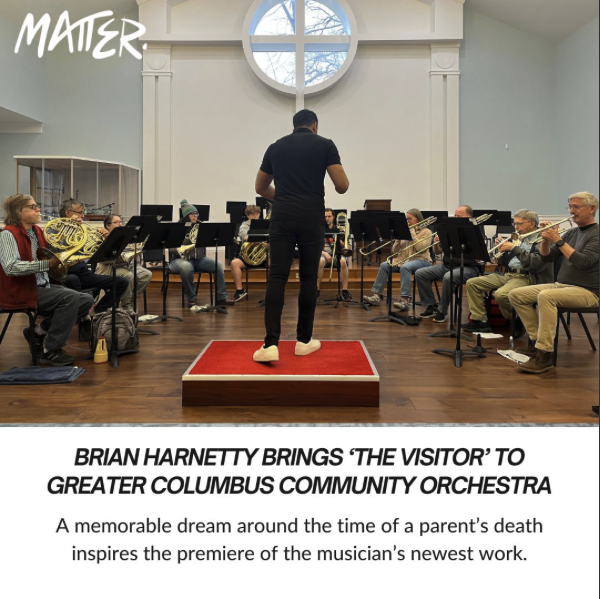THE VISITOR (2025)
Matter News
Last summer, Brian Harnetty’s mother, Marilyn, died at age 87 from Parkinson’s-related dementia. Her passing, which followed the 2021 death of Harnetty’s father, left the sound artist and composer feeling untethered, struggling to find the ground beneath his feet.
A few weeks before his mom died, Harnetty had a peculiar dream that sent waves of tingling sensations all through his body. The chaotic surges caused him to cry uncontrollably, but not necessarily out of sadness. Amid the pulsing sensations, he heard a voice repeating in a whisper, “Take care of yourself, take care.”
“It felt like it lasted a long time, and it was very upsetting, but it wasn’t super frightening,” Harnetty said. “The definition of ‘sublime’ is something that’s overwhelming – both in a beautiful sense, but also in a terrifying sense. So I guess it was that.”
Marilyn’s illness made it difficult to communicate with her as she neared the end, and that motherly directive – “take care” – is perhaps the goodbye Harnetty had wanted to hear. “But it wasn’t her who was visiting me [in the dream],” Harnetty said. “It was just… a visitor.”
When the opportunity arose for Harnetty to compose a piece of music for the Greater Columbus Community Orchestra, he began thinking about the dream and his mother. He wanted to write something that evoked a complex set of ideas and emotions: connection, intimacy, uncertainty, sadness and joy. On Sunday, April 6, at 7 p.m., GCCO’s brass section will premiere Harnetty’s resulting piece, “The Visitor,” at Hilliard Presbyterian Church. It’s the first of five pieces commissioned by GCCO and the Johnstone Fund for New Music over the next two years. (The April 6 program, titled “Unfinished” and featuring soloist Megan Amos on French horn, will also include Beethoven’s Overture to “The Creatures of Prometheus,” Schubert’s Symphony No. 8 in B minor (Unfinished) and Strauss’ Horn Concerto No. 1 in Eb major, Op. 11.)
At the all-volunteer orchestra’s rehearsal on a Monday night in late March, sunlight streamed into the sanctuary of Hilliard Presbyterian Church, reflecting off the brass instruments, making them shine even brighter than usual. Alex Toa conducted the musicians as Harnetty followed along from a nearby seat. The music built with static harmony and slow movement, getting louder and higher as it went. “This is what brass can do really well – these beautiful, lush chords,” Harnetty said. “That’s what I tried to exploit as much as possible.”
“The Visitor” is Harnetty’s latest in an inadvertent series of family portraits that includes “The Workbench,” a moving meditation on the loss of his father, and a forthcoming series of piano pieces based on his grandparents’ sheet music. Before his mom moved out of her Westerville home, Harnetty also went through the house, recording familiar sounds to create an audio portrait of the space – a project he’s now working on with Chamber Brews. “And then there’s a piece about my great-great-great-grandfather, who was a land surveyor during the Civil War,” he said. “It all just happened over the last couple of years, where family is right at the forefront.”
While the focus on family is relatively recent, the medium of sound – and music in particular – has always been the way Harnetty has made sense of the world. Even as a kid, he remembers getting physical, ASMR-like sensations from music, similar to the pulsing, tingling waves in the dream. “I call it a fever chill of joy,” said Harnetty, who still regularly finds himself deeply moved by music as an adult. After the 2023 performance of “The Workbench” at Short North Stage with members of the Unheard-of//Ensemble, he looked down at his smart watch and saw that an alarm had gone off during the performance. “My heart rate had gone crazy, and it lasted the exact 11 minutes of the piece,” he said. “People talk about being desensitized. This is like being sensitized.”
Inevitably, “The Visitor” will conjure similar feelings. “Hopefully I won’t be an emotional wreck when they perform. … But I feel like my job as an artist is to witness those things – the stuff with my family, the dying process. And the joyful stuff, too – the whole spectrum of the human experience. And then figure out a way to translate it and share it,” Harnetty said. “That might just be what the main job of an artist is.”

